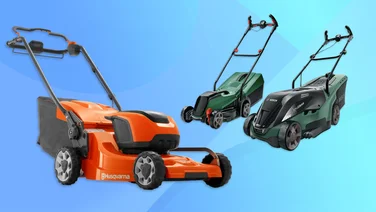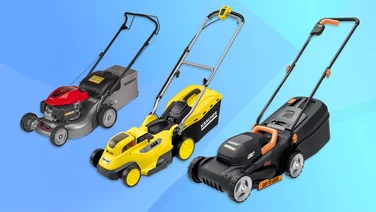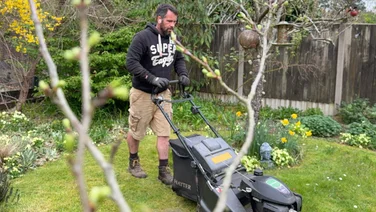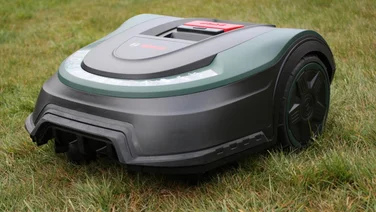To help us provide you with free impartial advice, we may earn a commission if you buy through links on our site. Learn more

Mowing the lawn consistently ranks amongst gardeners’ most hated jobs. Doing it right doesn’t mean endless hours of trundling back and forth, however: a well-organised lawn care regime can keep your grass healthy, thick and looking lovely all year round with a minimum of effort. Doing it wrong, however, can cost you time and money, and that’s why you need to take care to avoid the common pitfalls.
Indeed, there’s more to it than just grabbing your lawn mower and shunting it to and fro. Slow and steady wins the race, with care and consistency trumping the occasional violent shave. And if you’d rather keep mowing to a minimum, then don’t begrudgingly gouge every inch of your grass: alternatively, why not embrace Plantlife’s No Mow May and rewild awkward patches as a wild summer meadow.
In this article, I’ve researched key information from the people in the know, such as my friendly green-thumbed neighbours, and took the time to speak to a couple of lawn care experts, Paul Hicks, product and marketing manager at Stihl GB, and one of my local professional gardeners, Sophie Careless of Sophie’s Gardening, to get their expert advice on the mistakes you – and I – really need to avoid this season.
1. Mowing at the wrong time
- The first trim should be around mid-March to mid-April
If you’re itching to get the mower out, then take a breath. Grass doesn’t start growing again until the soil temperature exceeds 6℃, but even once it passes this threshold, cutting it too early can impact its health. Ideally, you don’t want to weaken it before any unexpected cold spells in February or March. Paul’s expert advice is that “It’s important to wait for the right weather conditions, ideally when the soil is around 7°C to 10°C – this is usually between mid-March and mid-April.”
Jump the gun, and Paul warns that you’ll reap what you mow come the summer: “One common mistake that gardeners often make is mowing too early in the year; this can cause stress to your grass, leave your lawn more susceptible to diseases and cause shallow roots and bare patches.”
Case in point: I trundled my mower out on an unusually balmy day in late March, gave my lawn its first haircut of the year and a frost descended the very following night. Expose a recently cut lawn to frost, and you can potentially stunt its growth, or even result in dieback and unsightly yellowing. In short, don’t be me: check the weather forecast for any impending overnight frosts, put it off a little longer, and make sure you follow rule no.2 below.
2. Cutting too much, too soon
- Never trim more than a ⅓ off the length
This is the biggest no-no by far. While it’s tempting to try to save time by giving it a brutal chop every time it gets a little too long, you’ll weaken the roots and make it more likely to struggle in the hottest and coldest parts of the year. Rush the cut and you’ll likely have a patchy lawn on your conscience for the rest of the year.
We’ve all found ourselves staring at an overgrown lawn, dreading the idea of doing multiple passes to get it back in shape – but, as Paul explains, that’s exactly what’s required if you want a healthy lawn. “An easy mistake to make when it comes to lawn care is cutting your grass too short, too quickly – especially when it is growing strongly during the spring and summer. A good technique to follow is the 1/3 rule; never trim more than a third of the length at one time. Gradually lowering the height over multiple mows, if necessary, is a much safer approach that reduces stress on the lawn.”
Cutting back too harshly risks stressing the plant, and stunting its growth. And while stunted growth might sound like a good thing for the more lazy mowers of lawns, you won’t like the results, according to Paul, “A more radical cut can easily damage your lawn, promoting weed growth and causing the grass to brown.”
3. Not varying your mowing pattern
- Regularly vary the cutting direction to avoid ruts and promote more even growth
In many parts of the garden, dogged consistency is an asset. But when it comes to mowing the lawn, variety is the spice. Mowing your lawn in the same direction time after time can stunt growth, as the mower’s wheels compact the soil and roots and can cause unsightly ruts to develop in your perfectly flat lawn.
Sophie agrees: “If you want a stronger, thicker lawn, then you need to vary your mowing pattern every time you mow. If you love the striped effect, then shift the mowing direction around 90 degrees every time, or consider mowing in circles or wavy lines.”
If you love the look of really pronounced stripes, then a healthy lawn provides the perfect canvas – and depending on the size of your lawn, you can experiment with stripes, circles, waves and criss-cross effects. Great results are easiest to achieve if you have a mower with a roller at the rear, but you can still get some good results with any mower – as long, that is, as your blades are sharp. Which leads us neatly onto our next point
4. Forgetting to maintain your mower blade
- Make sure the blade is sharp and your mower is clean
This is something I’ve definitely been guilty of. After all, even a dull metal blade spinning at several thousand RPM does a pretty effective job of cutting the grass. The problem, however, is that you can’t see the damage it’s doing until further down the line, and it’s something Paul expressly warns against, “Mowing with a dirty or dull blade can cause serious issues for your lawn. It can lead to an uneven lawn and frayed grass tips, which can cause the grass to turn yellow and leave it at risk of diseases. I would suggest cleaning the blades after every use, and sharpening after every 20 – 25 hours of operation.”
And while you might not think of cleaning your mower, Sophie recommends you keep on top of it: “Sharp blades are a must, but it’s also crucial to remove all the dried-on grass which sticks to your lawn mower’s cutting deck with a stiff brush. Do it every time you mow – it’s far easier than letting it build up and potentially damaging your mower.”
The advice is that it’s better to be safe than sorry. Paul’s advice is equally clear: “Before mowing, always inspect your mower’s blades to ensure they are clean and properly sharpened.”
But what should you do if they’re not? Well, if you’re a dab DIY hand with an angle grinder, or just a very coarse file, then you can remove the blade from the mower (no, don’t be tempted to leave it in place), pop it in a vice and get to work. Manual sharpening with a file will take a good while, but an angle grinder wielded correctly will do it in minutes. If you’re lacking the tools or, quite understandably, the confidence, then your local lawn mower repair shop should be able to do it for you at a cost of around £5. If your existing blade is too far gone, then consider replacing it – depending on your mower, they will cost roughly around £20 – £30
5. Mowing wet grass
- Always wait until your grass is dry before mowing
Again, resist the temptation to get it over and done with. Whether your lawn is wet with morning dew, drenched by rain or covered in frost, don’t even think about rolling out the mower until it’s dried off, or you’ll risk permanent damage to your grass. Sophie agrees that it’s a no-no: “Don’t be tempted to sneak in an early morning cut if there’s dew on the grass. It’s not just that it’s bad for your lawn – the sticky clumps of wet grass are a nightmare to clean up.”
Even if your lawn mower’s blades are sharp, wet grass is harder to cut. The result, as Paul reveals, isn’t pretty: “Tackling your grass while it is still damp means your mower is more likely to tear the grass blades instead of cutting them and can also lead to clumps being left on the lawn.”
It’s not just about your lawn’s health, either, as wet grass is heavier and stickier than the dry kind, so it’s harder on your hardware. Paul agrees: “Cutting your lawn before it’s dry enough can lead to lasting damage to your mower. It can clog up easily and increase strain on the motor.”Instead, if it’s damp, leave the mower in the shed, let the sun and wind do their bit and always check the lawn is nice and dry with a bare hand before setting the blades spinning. Paul’s advice is to be mindful of the fact that not all of your lawn will dry at the same rate: “It’s important to thoroughly check your lawn is dry after a rainy spell, especially in shaded areas as they will take longer to dry.”
6. Forgetting to scarify (or aerate) your lawn
- Never scarify your lawn in the hottest or coldest months – mild weather is ideal
No, this has nothing to do with horror movies or halloween. Scarifying your lawn is the process of using a rake to remove the thatch, or dead grass and moss, which can stop your lawn from getting the water and nutrients it needs. Aeration is another related lawn-care technique and this uses thin metal spikes to break up the soil, which can help air and water to reach your lawn’s thirsty roots. For more information on how to do this, read our full guide on How to aerate your lawn.
It’s one of Sophie’s top tips: “Once the grass starts growing again in March and April, and the temperatures rise, it’s the perfect time to consider scarifying and aerating your lawn. This will set it up for optimal growth throughout the season, and it’s also a great time to remove weeds and overseed your lawn to fill in bald patches.”
The equipment you need depends entirely on the size of your lawn, your budget – and how energetic you’re feeling. A spring-tined rake will work, but it’s a hard, tiring job even in smaller gardens – something I can testify to, being the owner of a very small lawn, a very well-used rake and sore shoulders from the beginnings of this year’s lawn care regime.
You can also buy specialised tools such as manual scarifiers – wheeled tools which roll over and dig out the thatch – or go the whole hog and consider powered scarifiers, which use powerful motors to spin a scarifying drum. These powered models often include an aeration drum in addition to the scarifier, so you can maximise your lawn health with a minimum of effort.
Sophie did have one word of warning, however: “Don’t be tempted to get ahead in the coldest or hottest months, as you can cause permanent damage to your lawn. You only want to be scarifying during the growing season when the temperature is mild – around 15℃ or so – and the grass has time to recover.”
7. Ignoring lawn edges
- Always trim your lawn edges before mowing
Again, mea culpa. Edge trimming is high up my list of most-hated garden tasks, so it’s something I’ve always neglected to do. The result is that the edges of my lawn are anything but crisply defined.
For my lawn, Paul’s warning comes too late: “Neglecting the edges of your lawn can leave it looking messy and unfinished. While it might be tempting to get stuck straight into mowing, I recommend trimming the edges first, every time you mow. Properly cutting the edge of your lawn creates a clean, polished finish that you will struggle to achieve with a mower alone; a cordless brushcutter will help you get the job done quickly and efficiently before you move on to mowing.”
If your lawn is too small to warrant a power tool, then a pair of edging or border shears will do a decent, if more time consuming job. This rather depends on your lawn having a nice defined edge, however, so you may want to grab yourself a lawn edger or straight-edged spade – not a curved shovel – and recut those edges for a perfectly perpendicular border. We’ve got a roundup of the best lawn edgers we’ve tested if you’re in need of adding one to your garden tool collection.
8. Mowing all of your lawn
- Mow parts of your lawn less regularly
Rewilding is something that’s gathered in popularity in recent years, but it’s a concept that most gardeners – particularly those blessed with larger gardens – have long learned to adopt as a time-saving necessity. Wildflowers and wildlife reap the benefit, and your garden can still look beautiful all year round.
This doesn’t mean leaving your garden to become completely overgrown. Instead, the Plantlife charity suggests adopting two or three different lengths of lawn. These can include shorter 2.5 to 5cm sections cut monthly; mid-length meadow areas cut two to three times a year outside of April-August, and completely un-mown areas left wild, which can restore much-needed habitats for hedgehogs, toads and taller flowers.
The key is to decide which parts of your lawn you want to look pristinely trimmed, and which of those you’d be happy to allow to grow more naturally. If there are areas that are simply too awkward to cut, then consider leaving them to grow, and reduce the mowing frequency to suit. For longer grasses, you can always park the mower and pick up the grass strimmer to keep them under control.






